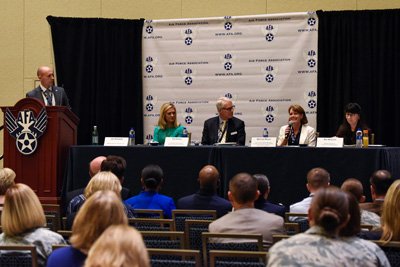Economic Insecurity for Military Families Predates Pandemic, Inflation
Mandi Afoa wanted a good cup of coffee. She had just moved to Fort Polk, Louisiana, from Texas with her husband, an active-duty Army captain, and their three children. She missed the coffee scene she’d left behind in San Antonio.
Afoa had begun working part time at her children’s school, something several other military spouses she knew did as well. Wages were low, Afoa says, and people were frustrated. She asked coworkers why they stayed at the job. It was the only work they could find, they told her.
Afoa and her husband started thinking. Military spouses needed—or even just wanted—to work, but they found options around base limited. People felt stuck in low-paying jobs or poor work environments. And then, there was that craving for good coffee.

Ted Hacker, American Freedom Foundation co-founder and president; Jen Griswold, military spouse entrepreneur; Melinda Manyx, Transition to Veterans Program Office, Department of Defense curriculum program manager; and Melanie McGuire, Civilian Force Management deputy director, participate in a panel discussion in 2018 about spouse employment during the Air Force Association’s Air, Space, and Cyber Conference in National Harbor, Maryland. Photo by Airman 1st Class Zoe M. Wockenfuss, courtesy of the U.S. Air Force.
The Afoas, it turned out, had a half-renovated trailer. Her husband offered to turn it into a coffee cart, and Afoa secured a spot on base. Last February, Koffee Kat was born. Afoa hires military spouses to work at her coffee stand and pays them $15.50 an hour—nearly double what teachers were making at her children’s school, she says.
But now, inflation is forcing Mandi Afoa to make hard decisions. Milk, eggs—the basics she relies on to run her business—cost far more than they did a year ago. Afoa says she doesn’t want to downsize her business or pass those costs along to her customer base: the soldiers and families on Fort Polk.
“That coffee shop is providing income for military spouses on base,” Afoa says. “There are some employees that we have that, by working 35 hours at the coffee shop, they make more than their husbands make.”
Like families across the country, military families are struggling with inflation. But the military community can face disproportionate challenges when the cost of living is high. Unlike in the civilian workforce, military salaries are set by law—getting a raise or a cost-of-living increase takes an act of Congress—and military families often do not qualify for federal assistance programs because of how military pay is structured.

Advisers help service members manage their budgets. Salaries are low for those just starting out in the military; base pay is about $20,000. Service members hoping to start a budget can contact their local Airmen and Family Readiness Center for a one-on-one meeting. Photo illustration by Staff Sgt. Kirby Turbak, courtesy of the U.S. Air Force.
Frequent moves, about every three years for most married service members, mean military spouses may scramble to find work or sustain careers. Military families are more likely to be one-income households, and they don’t always have a local support network that can pinch hit—a grandfather who can babysit or an aunt who can pick up the kids from school—when things get tough. State assistance available at one duty station, such as subsidized child care or free lunch programs, may not be available at the next. Taken together, this means military families, particularly those of junior enlisted members, can find it difficult to pay bills. Food banks near bases see more military members coming through, and research recently released by the Department of Defense found that nearly a quarter of all military families struggled to put food on the table in 2020.
“They’re having to choose between paying rent or paying their mortgage, and paying for healthy food for themselves and their families,” says Shannon Razsadin, the executive director of the Military Family Advisory Network, which supports military families.
To help offset rising inflation, this year’s National Defense Authorization Act includes a 4.6% pay raise for troops, the biggest jump in more than 20 years. It also includes an 11% raise for the Basic Allowance for Subsistence, which helps enlisted service members pay for food, and an average 12% bump in military housing allowances. In 2021, Congress also passed a “Basic Needs Allowance”—a new monthly payment for military families whose household income falls below 130% of federal poverty guidelines—which comes into effect this year. But the Department of Defense estimates that only about 300 families will qualify for the allowance, far fewer than those it estimates are food insecure, and the 4.6% pay raise does not keep pace with inflation.
“We’re anxious to see how the basic needs allowance and the increase in the basic allowance for housing will impact families,” Razsadin says. “Families have to get to a point where they can thrive financially and they can meet these basic needs, so that they can get to a place of overarching well-being.”
‘It Creates an Extra Hit on the Budget’
While Covid-19 and the economic instability that has followed have made things harder for families who serve, Razsadin and other advocates for military families say many of the factors that contribute to the financial hardship military families face predate the recent economic turbulence.

Magdylena Lopez, the daughter of an Army soldier stationed at Hunter Army Airfield, enjoys a free lunch from the Liberty County Summer Food Program on June 8, 2017, in Hinesville, Georgia. The program helps provide meals to kids free of charge as part of the county’s mission to alleviate food insecurity. Families are able to find a program site at many neighborhoods, parks, churches, and recreation centers throughout the county. Photo by Spc. Elizabeth Clark, courtesy of the U.S. Army.
In the 2000 presidential election, both Al Gore and George W. Bush pledged to increase military pay to help troops get off food stamps. In 1998, 6,300 active duty service members received food stamps, which Senator John McCain called a “national disgrace.” In 2019—before the Covid-19 pandemic began—22,000 active-duty service members received SNAP benefits. The rate of food insecurity in the military, at 24% in 2020, far outstripped the national average of 10.5%.
But in the absence of a more permanent solution, food assistance helps these service members feed their families. Even more military families could benefit from that government assistance if the way need is calculated were changed, advocates say. Under federal guidelines for determining food assistance, the basic allowance for housing—which military members receive as a nontaxable entitlement to help pay for housing—is considered income.
“It looks like it’s income, even though BAH is much more nuanced than that,” says Liza Lieberman, a spokesperson for MAZON, which works to end hunger and has advocated for better support for military families. “It’s not counted as income for tax purposes.”
“But unfortunately … when they’re calculating SNAP benefits, it does still count as income,” she says—meaning many families who might benefit from food assistance are rendered ineligible.
SNAP eligibility also varies by state, so a family that qualifies in one state might lose those benefits after a duty station transfer. The same goes for various state aid programs.
“We’ve heard stories of families moving from California, where there were free school meals for all children, to North Carolina where there wasn’t,” Razsadin says. “That creates an extra hit on the budget.”
Military base pay is the same for troops at a given paygrade, regardless of where they live. This year, after the congressionally mandated pay raise, a brand-new recruit will make $21,276. A corporal or a third-class petty officer who has been in the military for four years will make just shy of $35,000. Housing allowances for troops who live off base are adjusted by location and whether a service member has dependents—though how many they have is not part of the equation: A soldier with three kids gets the same allowance as a soldier with one. Some service members in a limited number of expensive cities may also get an additional cost-of-living allowance, depending on their years of service and the number of family members they support. In 2023, the Defense Department estimates that about 5,000 troops stationed across the United States will get that allowance. There are about 1.4 million troops in the U.S. military.
Award-Winning Journalism in Your Inbox
“I like to make this joke all the time—that isn’t really a joke—that when we moved from San Antonio, Texas, where the price of living was so high, to Fort Polk, Louisiana, we got a pay raise,” Afoa says. But the reverse is also true. “Living in San Antonio, we weren’t getting paid any more to live in an expensive city.”
Other realities compound the economic uncertainty that accompanies military moves. Although the military pays for families to move, they may not get it until after the move: Families often need to front the expenses of moving. Settling into a new duty station can mean scrambling to find child care—the wait for on-base child care can last years—and, crucially for military spouses, a job.

Thirteen community members—including military spouses, a veteran, and a National Guardsman—pose before being recognized June 30, 2017, in a graduation ceremony honoring the completion of a 10-week COMCAST customer service virtual class that secured their employment at the Hilton Garden Inn located a few miles from Fort Lee, Virginia. Photo by Amy Perry, courtesy of the U.S. Army.
“Military base pay doesn’t currently reflect who’s in the military now,” Lieberman says. “These policies and these figures haven’t really been reconsidered since decades ago, when it was usually an 18-year-old single male enlisting. Now it’s oftentimes going to be someone who is already supporting a family who’s enlisting, and they have more mouths to feed, and they might want to live off base where they can access better schools.”
But securing a second income to support those needs can be difficult for military spouses, as Afoa has found. In Onslow County, North Carolina, where Camp Lejeune is located, there were nearly 1,700 potential candidates for 33 job openings requiring a bachelor’s degree in January 2020. There were nearly 900 candidates for 17 associate’s degree-level jobs.
Securing a job can be a herculean effort—maintaining a career over a long period of time, Razsadin says, is even harder. “That has been a challenge for a lot of military spouses. It’s not a new issue. It’s a perennial issue.”
No ‘Culture of Comfort’ for Seeking Help
Defense Secretary Lloyd Austin has made improving the economic well-being of military families a cornerstone issue of his leadership, writing in a memo last fall that the department has a “sacred obligation” to care for its people.
In July, the department released a roadmap for improving food security in the force, which outlines efforts to increase access to healthy food across the services, as well as department-wide goals of improving spouse employment rates and reviewing pay and benefits.
In his fall memo, Austin mentioned many of the same issues, highlighting plans to expand multistate reciprocity agreements for various professional licenses, support remote work options for military spouses, and increase support for new parents. The memo also points to the 2023 increases in basic pay and housing allowance, and the new basic needs allowance.

Volunteers pose for a photo while packing bags with food to be distributed during the Military Family Advisory Network’s 1 million meal challenge at Manna Church, Oct. 23, 2021. Photo by Sgt. 1st Class Javier Orona, courtesy of the U.S. Army Reserves.
These efforts will help bring needed relief, advocates say. But particularly for measures that are controlled by Congress, advocates still worry about sustainability.
“For a long time, we’ve been concerned that the basic allowance for housing was not keeping up with what the market was indicating in specific locations,” Razsadin says. “And so having this increase will make a big difference. We’re hoping that this increase sticks.”
Changes made this year are not guaranteed for the future. For instance, the military’s housing allowance used to fully cover an area’s median rent and utilities, adjusted for pay grade and whether a service member has dependents. But since 2019, housing allowances have only been paid at 95% of the calculated median. Similarly, this year’s pay raise is lower than the rate of inflation, which in December was 6.5%. If next year’s raise doesn’t match with rising inflation, troops will fall further behind.
The economic well-being of service members can shift with political winds. A looming debt ceiling fight in Congress could lead to a government shutdown later this year. During a shutdown, military members keep going to work, but they don’t automatically get a paycheck. Congress must pass separate legislation to ensure troops get paid, which isn’t guaranteed.

Chief Aviation Electronics Technician Michael Tagg, the command financial specialist aboard the aircraft carrier USS Nimitz, discusses finances with a sailor in 2018. Photo by Mass Communication Spc. Seaman Greg Hall, courtesy of the U.S. Navy.
During the last government shutdown, in 2018, Congress did pass a bill to pay active-duty service members—but members of the Coast Guard, which falls under the Department of Homeland Security rather than the Defense Department, did not receive paychecks during the shutdown.
And then there’s the culture of the military itself, where troops are expected to put their heads down and get the job done. Some still see not being able to feed your family as a personal issue—and a source of shame.
Our Journalism Depends on Your Support
“There really isn’t a culture of comfort with asking for help,” Lieberman says.
But the attention the department is devoting to the problem is starting to make a difference, Razsadin says. She has seen longer lines at food distribution events run by the Military Family Advisory Network.
“That tells us two things,” she says. “One, it tells us the need is very much there. However, it also tells us that it might be getting a little bit easier for people to access the support. By acknowledging the fact that 24% have experienced food insecurity, people don’t feel as much like they are needing to struggle in silence. It has allowed people to feel heard and know that they’re not struggling in these issues alone.”
This War Horse feature was reported by Sonner Kehrt, edited by Kelly Kennedy, fact-checked by Jess Rohan, and copy-edited by Mitchell Hansen-Dewar. Michael de Yoanna contributed reporting. Headlines are by Abbie Bennett.





Comments are closed.